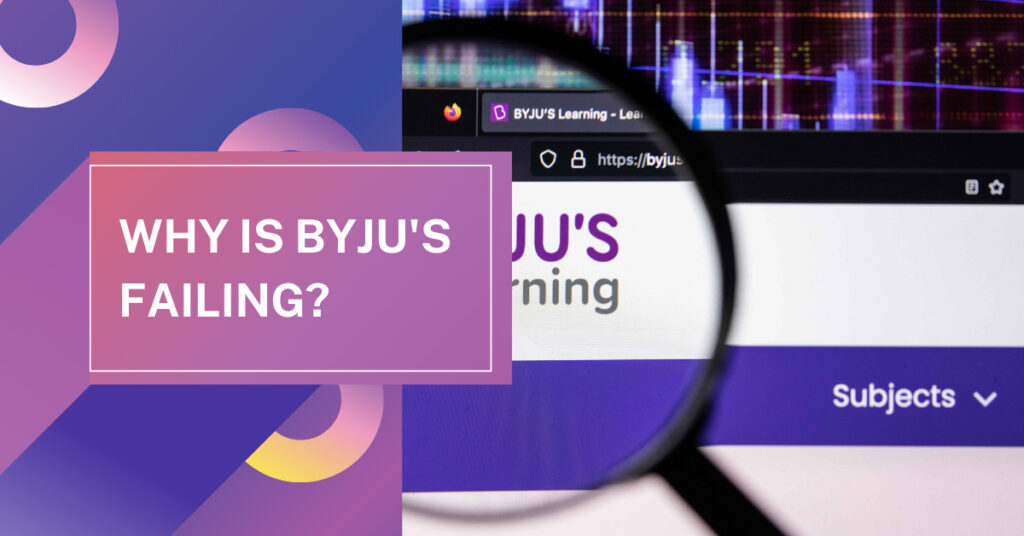Analyzing the Rise and Fall of Byju’s Amidst the Indian Startup Bubble.
The ed-tech unicorn Byju’s appeared to have everything in recent years, including rapid expansion, significant finance, and a bright future. But a swift turn of circumstances has left many perplexed, asking, “Why is Byjus failing?” Byju’s startup narrative will be examined in this blog article, along with the elements that contributed to its spectacular ascent and the difficulties that ultimately caused it to fail. Join us as we explore the crucial factors determining the company’s income in the context of the intensely competitive Indian startup scene, as well as the reasons behind Byju’s termination.
The rise of Byju’s and the ed-tech revolution
As we begin our exploration, let’s first understand how Byju’s became a behemoth in the ed-tech space. The company’s journey began with a vision to revolutionize the traditional education system and make learning engaging and accessible to all. Byju’s innovative approach, combining interactive content with personalized learning, resonated with millions of students and parents, propelling the startup to great heights.
A bubble in the making: the Indian startup’s scene
Before delving into Byju’s specific challenges, we need to address the bigger picture—the Indian startup bubble. Over the past decade, India witnessed a surge in startups, backed by enthusiastic investors and unprecedented funding rounds. However, not all of these ventures could sustain their initial momentum, and this bubble of unbridled optimism eventually burst, leading to a reality check for many startups, including Byju’s.
The challenges faced by Byju
1. Market saturation and competition
The ed-tech market in India became saturated, with numerous players vying for a share of the pie. Established competitors and emerging startups intensified the competition, making it challenging for Byju to maintain its market dominance.
2. Scaling and operational hurdles
Rapid expansion posed operational challenges, affecting the quality of customer service and content delivery. The inability to manage growth effectively led to customer retention issues.
3. Overreliance on fundraising
Byju’s heavily relied on continuous fundraising, creating immense pressure to deliver unrealistic growth targets. The focus on scaling without solid revenue streams led to an unsustainable business model.
The layoff decision and its impact
As Byju faced mounting challenges, the company made the difficult decision to implement a layoff, affecting a significant portion of its workforce. This move not only highlighted the severity of the company’s struggles but also had repercussions on employee morale and public perception. The layoff decision brought Byju’s internal issues to the forefront, questioning the company’s ability to weather the storm and its approach to talent management.
The decline in revenue and investor confidence
1. Revenue growth stagnation
Byju’s was initially hailed as a unicorn, but its revenue growth began to stagnate due to market saturation and increased competition. The failure to diversify revenue streams and overreliance on a few flagship products limited its potential for sustainable growth.
2. Investor confidence erosion
As revenue growth declined, investor confidence in Byju wavered, leading to reduced funding and tougher scrutiny of the company’s financial performance. The inability to meet revenue targets and the challenges posed by competitors impacted the overall perception of Byju’s as a secure investment.
The path to redemption: learning from failures
Despite the challenges and setbacks, every failure presents an opportunity to learn and rebuild. Byju now stands at a crossroads, where it must reassess its strategies and refocus its efforts. Key steps towards redemption include:
1. Reinventing the business model
Byju’s needs to evaluate and revamp its business model, moving towards a sustainable approach that aligns with the current market realities.
Exploring new revenue streams and product offerings can help diversify the company’s portfolio.
2. Prioritizing customer experience
Improving customer service and enhancing the overall learning experience can win back the trust of existing users and attract new customers.
Personalization and user feedback should drive content development and platform improvements.
Conclusion
The success and failure of Byju teach the entire Indian startup ecosystem an important lesson. It serves as a sobering reminder that even the most prosperous endeavours may run into difficulties and suffer disappointments. Entrepreneurs can be inspired by Byju’s journey to exercise caution, prioritise sustainability, and pay attention to how the market is developing. Byju is navigating through a challenging time, but the lessons it has learnt from its mistakes can help other entrepreneurs on their journeys to success.

